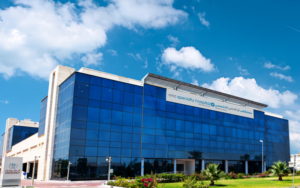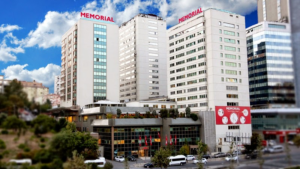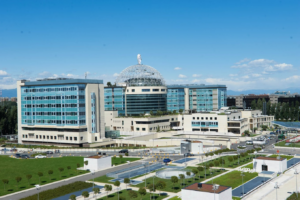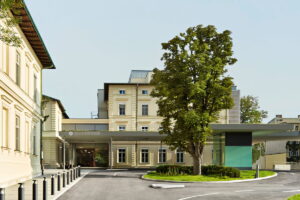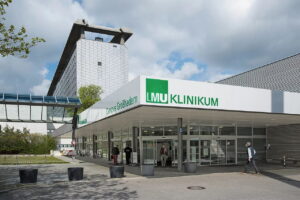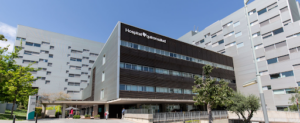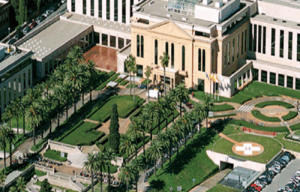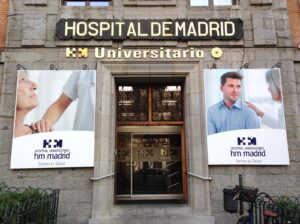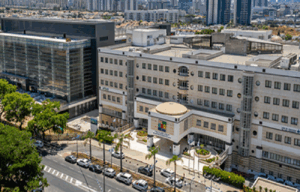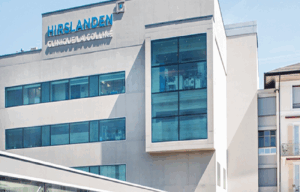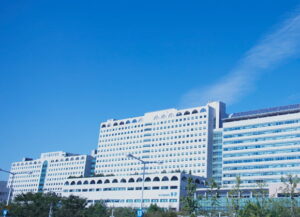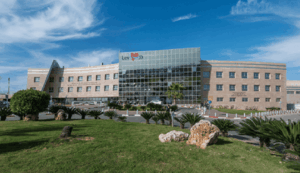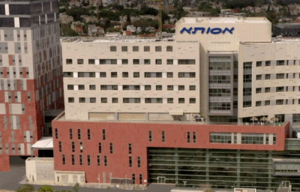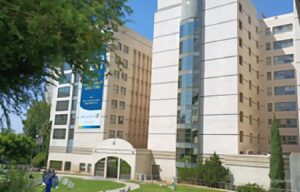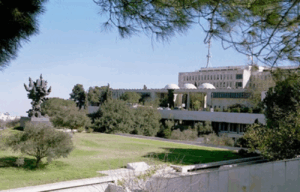Osteosarcoma
Disease description
Osteosarcoma, also known as osteogenic sarcoma, is an aggressive malignant tumor that originates from bone-forming cells. It is the most common primary malignant bone tumor.
Osteosarcoma most frequently affects the long tubular bones of the upper and lower limbs. The most typical site of origin is the area around the knee joint. However, the disease can also develop in other bones such as the humerus, pelvic bones, ulna, fibula, and cranial bones. The metaphysis — a part of the bone responsible for growth in children and located between the diaphysis (the shaft of the bone) and the epiphysis (the enlarged end of the bone) — is particularly prone to involvement.
The tumor can extend beyond the bone, infiltrating surrounding soft tissues such as muscle, adipose tissue, and tendons. Additionally, malignant cells can spread through the bloodstream and form metastases in distant organs, most commonly the lungs. In some cases, metastases may occur in other organs, including the brain or other skeletal bones.
Osteosarcoma predominantly affects young individuals during periods of active bone growth and is more commonly diagnosed in male patients. People diagnosed with retinoblastoma (a malignant tumor of the retina) are also at higher risk.
Symptoms
Unfortunately, in the early stages, the disease is often misdiagnosed. Incorrect diagnoses such as myositis, neuralgia, or post-traumatic conditions may delay accurate diagnosis and the initiation of appropriate treatment, which adversely affects prognosis. Therefore, in cases of persistent, unexplained bone pain, it is crucial to consult an oncologist to rule out a tumor.
The most common symptom is pain near a joint, which intensifies at night or during physical activity. For example, if the leg bones are affected, it may result in limping. In early stages, this pain is often mistaken for muscle strain or trauma. However, unlike those conditions, the pain associated with osteosarcoma does not subside over time but rather worsens.
As the tumor progresses, additional symptoms develop. Swelling may appear in the affected bone region and increase over time. The skin over the tumor may become edematous, and dilated venous networks may become visible. The pain becomes more intense, limiting the range of motion in the adjacent joint. In some cases, pathological fractures may occur, although this is relatively uncommon.
Diagnosis and treatment for osteosarcoma in children
Diagnosis
The diagnostic process begins with radiographic imaging of the affected area in two projections. The X-ray often reveals bone destruction and a characteristic formation known as a “Codman’s triangle,” indicating periosteal elevation due to tumor growth.
Once a tumor is suspected, a biopsy is performed to obtain a tissue sample for microscopic examination to confirm the diagnosis.
For a more detailed assessment, computed tomography (CT) is used to evaluate both the intraosseous component of the tumor and its spread into adjacent soft tissues such as muscles and fat. Magnetic resonance imaging (MRI) provides additional information, particularly about the bone marrow cavity of the affected bone and potential metastases to the central nervous system.
Chest radiography or CT of the thorax is performed to detect lung metastases. Bone scintigraphy (osteoscintigraphy) is used to identify metastases in other bones or detect multifocal osteosarcoma.
Biochemical blood analysis has prognostic significance: elevated levels of lactate dehydrogenase (LDH) and alkaline phosphatase (ALP) are often associated with a more aggressive disease course.
Treatment
The main step in osteosarcoma treatment is surgical resection of the tumor. If the tumor cannot be surgically removed — such as in cases involving the skull base or spine — the prognosis is significantly worse.
Several decades ago, surgery for osteosarcoma in the limbs often resulted in amputation. Today, thanks to advances in international medicine, limb-sparing procedures are possible in most cases. The affected bone segment and surrounding tissues are resected and replaced with a prosthetic implant or bone graft. In pediatric patients, expandable endoprostheses are frequently used, allowing the prosthesis to be lengthened as the child grows. However, when the tumor involves critical neurovascular structures, amputation may still be unavoidable.
In some cases, surgical resection of large metastases, particularly in the lungs, may also be performed.
Since osteosarcoma spreads rapidly, surgical resection alone is usually insufficient. Even in the absence of detectable metastases, chemotherapy is essential, as survival rates are significantly lower without it. Chemotherapy is administered both preoperatively (neoadjuvant chemotherapy) to shrink the tumor and postoperatively (adjuvant chemotherapy) to eradicate residual malignant cells. After tumor removal, the excised tissue is analyzed to evaluate the effectiveness of the preoperative chemotherapy and to guide further treatment.
Radiation therapy is rarely used in osteosarcoma because tumor cells generally exhibit low radiosensitivity.
Innovations in global clinics
Targeted therapy aims to block specific molecular targets that promote tumor growth and survival. One example is the use of tyrosine kinase inhibitors, such as sorafenib and regorafenib. These drugs inhibit the activity of specific proteins involved in osteosarcoma progression and may slow or halt its development. Targeted therapy is currently being used for the treatment of complex and treatment-resistant forms of osteosarcoma in children and adolescents in Europe and the United States.
Top clinics
-
 Max Grundig Clinic
Max Grundig Clinic -
 University Hospital Freiburg
University Hospital Freiburg -
 Acibadem Altunizade Clinic
Acibadem Altunizade Clinic -
 Medistate International Hospital
Medistate International Hospital -
 Medical Park Antalya Clinic
Medical Park Antalya Clinic -
 Dubai, UAE NMC Healthcare
Dubai, UAE NMC Healthcare -
 Shishli Memorial Clinic.
Shishli Memorial Clinic. -
 Milan, Italy San Raffaele University Hospital
Milan, Italy San Raffaele University Hospital -
 American Hospital Dubai
American Hospital Dubai -
 Burjeel Hospital Abu Dhabi
Burjeel Hospital Abu Dhabi -
 Debling Private Clinic
Debling Private Clinic -
 Rudolfinerhaus Private Clinic.
Rudolfinerhaus Private Clinic. -
 University Hospital Heidelberg
University Hospital Heidelberg -
 Vienna, Austria Wiener Privatklinik (WPK)
Vienna, Austria Wiener Privatklinik (WPK) -
 Munich, Germany University Hospital Munich (Ludwig-Maximilians-Universität)
Munich, Germany University Hospital Munich (Ludwig-Maximilians-Universität) -
 Charité Clinic
Charité Clinic -
 Lindbergh Clinic
Lindbergh Clinic -
 Clinique Genolier
Clinique Genolier -
 Barcelona, Spain QuironSalud Barcelona Hospital
Barcelona, Spain QuironSalud Barcelona Hospital -
 Barcelona, Spain Medical Center "Teknon"
Barcelona, Spain Medical Center "Teknon" -
 Barcelona, Spain Sant Joan de Deu Children's Hospital
Barcelona, Spain Sant Joan de Deu Children's Hospital -
 Barcelona, Spain University Hospital Barnaclinic+
Barcelona, Spain University Hospital Barnaclinic+ -
 Madrid, Spain University Clinic HM Madrid
Madrid, Spain University Clinic HM Madrid -
 Madrid, Spain University Hospital HM Monteprincipe
Madrid, Spain University Hospital HM Monteprincipe -
 Zurich, Switzerland Hirslanden Clinic
Zurich, Switzerland Hirslanden Clinic -
 Madrid, Spain Quiron Salud University Hospital
Madrid, Spain Quiron Salud University Hospital -
 Duesseldorf, Germany Oncological Center Dusseldorf
Duesseldorf, Germany Oncological Center Dusseldorf -
 Petah Tikva, Israel Schneider Children's Medical Center
Petah Tikva, Israel Schneider Children's Medical Center -
 Seoul, South Korea Samsung Medical Center
Seoul, South Korea Samsung Medical Center -
 SNUH
SNUH -
 г. Женева, Швейцария Клиника «Женераль-Болье»
г. Женева, Швейцария Клиника «Женераль-Болье» -
 г. Женева, Швейцария Hirslanden Clinique La Colline
г. Женева, Швейцария Hirslanden Clinique La Colline -
 г. Сеул, Южная Корея Медицинский центр «Асан»
г. Сеул, Южная Корея Медицинский центр «Асан» -
 г. Рамат-Ган, Израиль Клиника Шиба
г. Рамат-Ган, Израиль Клиника Шиба -
 г. Тель Авив, Израиль Медицинский центр “Ассута”
г. Тель Авив, Израиль Медицинский центр “Ассута” -
 г. Петах-Тиква, Израиль Медицинский центр имени Ицхака Рабина
г. Петах-Тиква, Израиль Медицинский центр имени Ицхака Рабина -
 г. Иерусалим, Израиль Медицинский центр “Хадасса”
г. Иерусалим, Израиль Медицинский центр “Хадасса”




